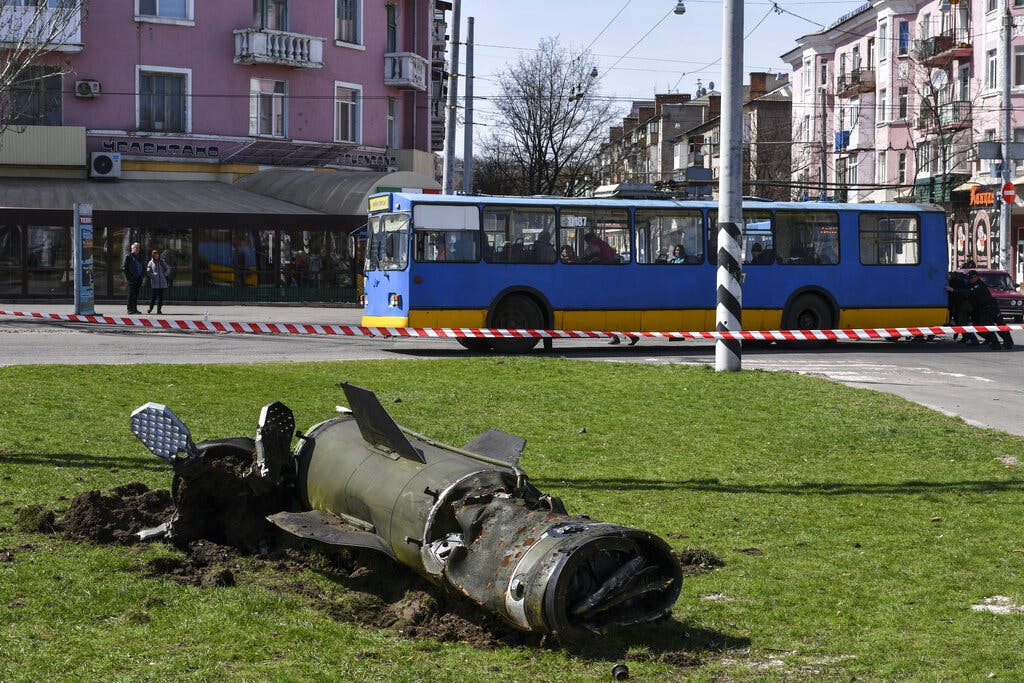Mere Miles from Russian Positions, Ukrainians in Donbas Grapple With Staying or Fleeing
Compared to previous strikes against larger population centers, missile strikes hit Sloviansk in only small numbers, lulling the city’s civilian population into a false sense of security.

SLOVIANSK, Ukraine — As Russia’s war machine falters around Kharkiv, Moscow’s troops push deeper into Ukraine’s Luhansk and Donetsk Oblast regions, prompting the families and individuals that remain to ask themselves: Should I stay — or should I flee?
The two oblasts in Ukraine’s east form the Donbas, a portmanteau cobbled from Donetsk Basin, a coal- and iron-rich region pocked with open-pit mines and vast mountains of mining waste soil tips.
Donbas’s mineral wealth during the Russian imperial and later Soviet eras transformed the region into a metallurgical and industrial center and fed the USSR’s enormous appetite for coal-powered heavy industry.
Russian forward positions run through Donbas, a front that unpredictably writhes and shifts. Two of the largest cities in free Donetsk Oblast — Kramatorsk and Sloviansk — lie in the shadow of Moscow’s war machine.
The mayor of Sloviansk, Vadim Lyah, told the Sun that “for now — and I hope it will continue this way — the fighting is taking place 30 to 40 kilometers from the city.”
Compared to previous strikes against larger population centers, missile strikes hit Sloviansk in only small numbers, lulling the city’s civilian population into a false sense of security.
“The artillery of the enemy does not reach the city,” Mr. Lyah explained. “That … may be misleading for the population situation, that there’s an impression that everything’s okay.”
Many of Sloviansk’s last holdouts are too old or infirm to flee westward and instead choose to hunker down at home as best they can.
Others remain in place because they cannot conceptualize building a new life anywhere but where they have always lived and called home.
Even in the face of the Russian army, uprooting is a difficult prospect. “There is a high percentage of people who have never left” the Donetsk region “in their whole life,” Mr. Lyah explained.
“So it’s mentally difficult to leave, there’s a fear of sorts, that the Western oblasts that are far away, are almost like another country for them.”
A severe fuel shortage compounds Ukrainians’ sense of apprehension. The shortage is acute in the country’s eastern regions, truncating some city services, and alternative means of transportation — gas-sipping motorcycles and scooters, as well as bicycles — are increasingly popular.
Oleksiy Ovchnnykov, a 43-year-old dance instructor and business owner, explained that his grandmother is in good health but has absolutely no desire to leave Konstantinovka, a small town about 10 miles from the front line.
The 94-year-old has lived through two occupations since 1928 — that of the Nazis in 1943-44 and a shorter one under pro-Russian separatists in 2014. Although the situation is far from safe, he can sympathize with her.
Even if the Russians do not take and occupy Kramatorsk or Sloviansk, the costs of a concerted bombing campaign to the civilian population could be enormous.
As civilian infrastructure collapses, “when there is no electricity, water, and gas, then naturally the percentage of people wishing to leave increases,” Mr. Layh said. “But the opportunities for a full-fledged evacuation shrink as well.”
The area north of the city is no man’s land, and the villages caught in the cross-fire of artillery duels between the Russians and Ukrainians are mostly devoid of life.
There are “movements forward, and movements back immediately after,” Mr. Lyah said, but most of the fighting takes place 30 to 40 kilometers away from the city.
Although war rages outside of Sloviansk and Kramatorsk, both cities are largely out of range of Russia’s artillery pieces, but long-range missiles and stand-off munitions dropped from Russian aircraft still hit on occasion.
Struck by these types of munitions, Sloviansk and Kramatorsk have borne witness to some of the most violent, brutal attacks of this war.
The memory of one recent Russian missile strike against Kramatorsk’s central train station last month is still at the forefront of some residents’ minds — a collective recollection that won’t soon be erased.
Anton Malyusky, a 40-year-old Kramatorsk native, worked at the train station the day of the attack as a volunteer, helping coordinate evacuations for Ukrainians fleeing westward.
Mr. Malyusky’s colleagues went outside to the train platform “and suddenly heard a massive explosion.” Residents have become accustomed to the sounds of war, but this was different.
“I realized at once that this one had hit us directly,” he said, because “the sound was much closer, and immediately there were people lying on the ground everywhere.” A cluster bomb hit the station, scattering bomblets “everywhere.”
The Russian missile struck the station “precisely at rush hour,” Mr. Malyusky said. There were approximately 4,000 evacuees at the station, mostly women and children. The carnage was “awful.”
Although Mr. Malysky and some of his colleagues managed to scramble out of the station unscathed, the memory of what they saw still brings him to tears.
“There was a pile of dead bodies,” he said, adding that he saw “many wounded, with horrible injuries and limbs blown off.… All around, just blood, groans, cries for help, burning vehicles.”
Mr. Malysky was “okay afterwards,” but many of the survivors were “badly traumatized” and suffered from nervous breakdowns after the attack.
“It was the worst thing I’ve ever seen in my life,” Mr. Malysky said. “And hopefully it will stay that way.”

